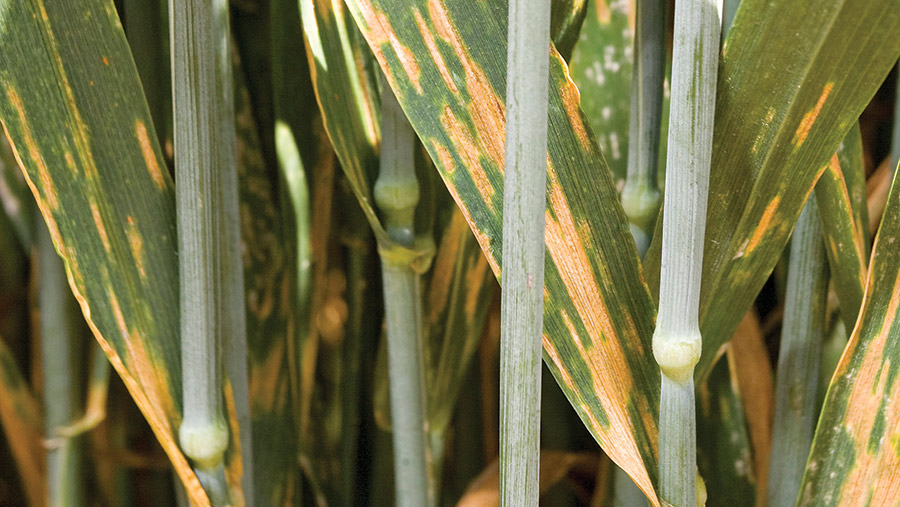Keep cereal fungicide rates high to ward off SDHI resistance
 RBI Copyright
RBI Copyright Cereal growers are being urged to keep their fungicides rates up this season to prevent resistance developing to the key group of SDHI products.
Strains of wheat’s most damaging disease septoria were found to be resistant to SDHIs in Ireland last year sparking fears these fungicides could become less effective.
See also: SDHI fungicide-resistant septoria found in Irish fields
Andreas Mehl, fungicide resistance expert at agrochemicals giant Bayer, advises that growers need to adhere to advice from experts to keep these fungicides effective.
His three-point guidance is to keep fungicide rates high, use SDHIs no more than twice in a season and also use multisite fungicides early in the season to prevent resistance developing.
“The golden rule is not to go below 75% of the label rate for SDHI products. We need to keep SDHI chemistry effective for as long as possible,” he tells Farmers Weekly.
Many SDHI products are sold as ready mixes with azole fungicides, such as Bayer’s Aviator, but if mixes are done on farm then both SDHIs and azoles need to be at least the 75% label rate.
Mixing fungicides
The SDHIs and azoles have different modes of action, so both need to be used at effective rates to protect against resistance building up against either of these two fungicide groups.
He suggests growers only use an effective azole, such as prothioconazole or epoxiconazole, to protect the SDHI, while using the SDHI in the mix protects the efficacy of the azole.
Dr Mehl also emphasises the current independent guidelines to use a maximum of two SDHIs in a season, and advises the use of a multisite protectant fungicide, such as chlorothalonil, in the early part of the season.
“Multisites can help prevent the spread of less sensitive populations especially at the T0 and T1 timing,” he says.
Experts say the consistent use of site-specific fungicides such as SDHIs can result in the selection of resistant fungal genotypes which may ultimately lead to a decline in fungicide performance.
That is why independent advice is to use SDHIs only in mixtures and limit their use per season, and so try to avoid the rapid loss of efficacy of the strobilurins to septoria.
Disease monitoring
Dr Mehl has been monitoring disease resistance since the first SDHI product appeared on the market in 2005 with the launch of boscalid.
A second generation of SDHIs entered the market in 2011 with the launch of Bayer’s Aviator and Syngenta’s Seguris to be quickly followed by BASF’s Adexar and then DuPont’s Vertisan.
It was in 2012 that the first signs of mutations were detected in the septoria fungus which could have led to resistance, so Dr Mehl’s work looking at possible resistance to Bayer’s SDHI component in Aviator, bixafen, was stepped up.
Dr Mehl’s monitoring work in 2015 at UK and Irish sites showed no hint of resistance, but there were some strains of septoria showing signs that they could mutate and might lead to resistance.
“Where mutations are detected, we need to watch and see if they have a significant effect on field populations,” he says.
One strategy Dr Mehl does not advocate is rotating SDHIs or even azoles in the season as he says there is no evidence to show this would prevent resistance building up.
“Rotating between prothioconazole and epoxiconazole for resistance management makes no sense,” he adds.
Key SDHI products and UK launch dates
- Tracker – SDHI boscalid + azole epoxiconazole (2005)
- Aviator – SDHI bixafen + azole prothioconazole (2011)
- Seguris – SDHI isopyrazam + epoxiconazole (2011)
- Adexar – SDHI fluxaproxad + epoxiconazole (2012)
- Vertisan – SDHI penthiopyrad (2013) plus a selected azole
Key points to prevent SDHI resistance
- Keep rates of SDHI-azole products to at least 75% label rate
- Use a maximum of two SDHI applications per season
- Use multisite fungicides, especially early in the season

